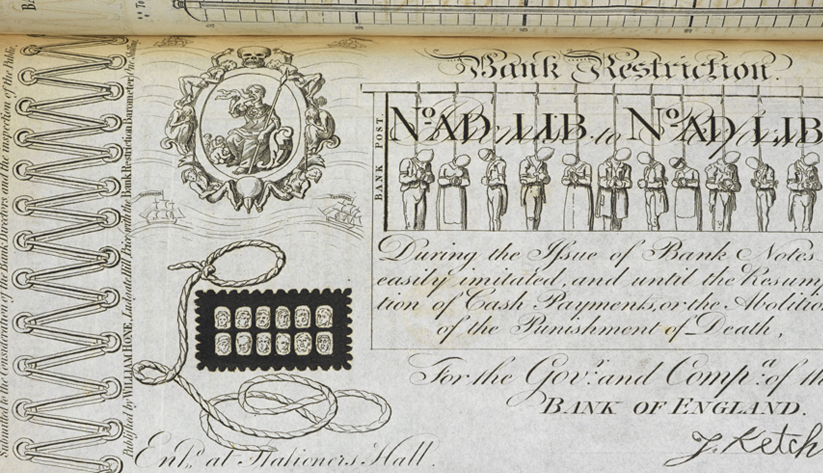
An 1819 cartoon lampooning the Bank of England’s method of dealing with
counterfeiters of its banknotes.
The troubled introduction and subsequent embrace of central bank–issued notes during and after Europe's Renaissance might provide guidance as the Federal Reserve explores the implications of issuing digital currency.
Atlanta Fed economist Will Roberds undertook this historical examination in his Policy Hub article, "Unstable Coins: The Early History of Central Bank Analog Currencies." Roberds observed that many central banks' efforts to introduce banknotes went awry—often spectacularly—following a successful launch in 16th-century Naples. Nearly 300 years passed before the turmoil settled. By the late 1800s, central bank notes had become commonly accepted across Europe, and the Bank of England was busy printing currency.

The Atlanta Fed’s Will Roberds. Photo by David Fine
Do lessons from history apply to today's decisions?
Roberds's article looks at whether the process of establishing banknotes could inform the Federal Reserve's ongoing evaluation of a central bank digital currency (CBDC) and is part of a larger and ongoing dialogue. The Fed's Board of Governors has issued a discussion paper about CBDC, and the Atlanta Fed's recent Financial Markets Conference featured a panel discussion titled "Which CBDC, If Any, Is Right for the United States?" Further, a recent installment of the Atlanta Fed's Talk About Payments webinar focused on Project Hamilton, a collaborative effort between the Boston Fed and Massachusetts Institute of Technology’s Digital Currency Initiative intended to inform the challenges and choices involved in devising a theoretical high-performance and resilient transaction processor for a CBDC.
In his article, Roberds described instances of "egregious fraud, a real estate finance bubble, hyperinflation, rampant counterfeiting, and complete institutional collapse." Despite these numerous mishaps, this raucous chapter of modern currency ends in an economy in which "central bank–issued notes eventually became the default form of payment in virtually every country worldwide."
The examples Roberds used in his article illustrate the pitfalls and benefits that financial disruptors share across history, with innovative policies and practices sometimes advancing—and sometimes derailing—the global adoption of a notes-based payment system. Here are summaries of some of the case studies from Roberds’s article.
Amsterdam: Banknote fraud treated seriously
In the 17th century, the Netherlands used the death penalty to deter fraudulent banknote issuance. A pamphlet shows the apparent beheading in 1673 of Rutgert Vlieck, a bank clerk who was found to have issued "hundreds of guilders in bogus notes…a multiple of the bank’s annual profit." Bank officials determined execution was the only appropriate response to maintain its reputation with Amsterdam merchants. The bank ultimately decided to leave the business of issuing notes to firms known as cashiers, focusing instead on the large-value payments of wealthy merchants.

A cautionary poster from the Bank of Amsterdam.
Sweden: Abrupt failure, then too much success
Sweden is famous for its early banknotes. The Stockholm Bank, chartered in 1657, issued notes that were preprinted, numbered, and decorated—until the bank collapsed in 1667, in part because it overissued notes and couldn't back them with coins. Public distrust of bank notes persisted until 1701, when a circulating banknote reappeared and served until a new political party won control of the country in 1739. That party implemented policies that resulted in notes becoming irredeemable in coin after 1745.
England: Storied success and a public relations disaster
By 1800, the Bank of England was seeking the execution of both counterfeiters and those found to be holding counterfeit notes. Its wholesale service (consisting of large-value transactions used primarily by financial institutions) had been a success and led its expansion to smaller denominations intended for the general public. (Its banknotes had also been a success in raising money for the crown.) Counterfeiters targeted the smaller notes, and the bank responded with vigorous prosecution. Execution was the only legal penalty, and 77 people were hanged at the peak of the anticounterfeiting campaign in 1820. The public revolted against the penalty, and the bank successfully petitioned for a new law that instead allowed convicts to be banished to Australia for 14 years.
The Bank of England began experimenting in the 1820s with provisions intended to fully back banknotes with "safe assets" to be used to redeem their value. The enactment of the 1844 Bank Charter Act was intended to fully back notes with bank securities or a precious metal, typically gold. The intent was negated as the private sector found means to circumvent the law.
France and Austria: Fiscal dysfunction
The Bank of England's success in raising money for the crown was a siren call for France and Austria, who formed banks to issue notes. However, their governments couldn’t refrain from exploiting banknotes for their own fiscal purposes. France's first bank, chartered in 1716, "took on the flavor of a Ponzi scheme," as Roberds put it, and collapsed in four years. Austria's first bank sputtered out in two years, in 1703, and its successor presided over a note system that resulted in people melting down their undervalued gold, silver, and copper coins amid a 20 percent spike in food prices in 1811. Owners of original banknotes took a 92 percent haircut.
Lessons learned and the road ahead
Roberds noted the public's acceptance of banknotes in in his article when discussing whether today's public would accept a US CBDC: "Counterbalancing these largely cautionary measures, however, is the meta-message that provision of a lower-cost method of transacting can be very valuable to society, as evidenced by the (eventual) widespread adoption of central banks' notes."

The Atlanta Fed’s Oz Shy. Photo by David Fine
This year in Georgia, state lawmakers considered legislation to require merchants to accept cash payments for goods and services. Though not enacted, the proposal did spur conversation about the rising tide of merchants going cash-only. House Bill 1152 was introduced by four Democrats who represent some lower-wealth neighborhoods in metro Atlanta and the Augusta area.
The Georgia proposal tracked similar measures enacted in Massachusetts and New Jersey, and cities including New York, Philadelphia, and San Francisco, according to descriptions of the state laws and local ordinances in a 2021 report by Stateline, a publication of the nonprofit Pew Charitable Trusts. Atlanta Fed economist Oz Shy observed similar patterns in his 2019 working paper "Cashless Stores and Cashless Users."

The Federal Reserve’s Lael Brainard. Photo courtesy of the Board of Governors
Shy cited an outlier in the data that could pertain to any retail use of a CBDC: transaction costs associated with the payment instrument, also an observation Roberds made in his article. Shy noted that researchers have been unable to pinpoint the cost at which consumers who are able to pay by digital means shift from cash to cashless payments. Consumer choice can be based on variables such as the fees and availability of an ATM, the cost of loading funds into a payment card, and, for credit cards, whether the use is for convenience or for borrowing.
Lael Brainard, vice chair of the Board of Governors, outlined the complexities
of the CBDC decision-making process in a
recent speech. "It is prudent to explore whether there is a role for a CBDC to preserve
some of the safe and effective elements of the financial system of the present
in a way that is complementary to the private sector innovations transforming
the financial landscape of the future," she said. "To prepare for the
financial system of the future, the Federal Reserve is engaging in research
and experimentation with these new technologies and consulting closely with
public and private sector partners."



